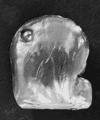- pearl
-
pearl1
/perrl/, n.1. a smooth, rounded bead formed within the shells of certain mollusks and composed of the mineral aragonite or calcite in a matrix, deposited in concentric layers as a protective coating around an irritating foreign object: valued as a gem when lustrous and finely colored. Cf. cultured pearl.2. something resembling this, as various synthetic substances for use in costume jewelry.3. something similar in form, luster, etc., as a dewdrop or a capsule of medicine.4. something precious or choice; the finest example of anything: pearls of wisdom.5. a very pale gray approaching white but commonly with a bluish tinge.6. mother-of-pearl: a pearl-handled revolver.7. Print. a 5-point type.8. Also called epithelial pearl. Pathol. a rounded mass of keratin occurring in certain carcinomas of the skin.9. cast pearls before swine, to offer or give something of great value to those incapable of appreciating it: She read them Shakespeare but it was casting pearls before swine.v.t.10. to adorn or stud with or as with pearls.11. to make like pearls, as in form or color.v.i.12. to dive, fish, or search for pearls.13. to assume a pearllike form or appearance.adj.14. resembling a pearl in form or color.15. of or pertaining to pearls: pearl diving.16. set with a pearl or pearls or covered or inlaid with pearls or mother-of-pearl: a pearl necklace.17. having or reduced to small, rounded grains.[1300-50; ME perle < MF < It or assumed VL *perla ( > G Perle, OE paerl), for L *pernula ( > Pg perola, perh. OS përula), dim. of L perna sea mussel]pearl2/perrl/, v.t., v.i., n.purl1.
* * *
IConcretion formed by a mollusk and consisting of the same material (called nacre, or mother-of-pearl) as the mollusk's shell.Long treasured as gemstones, pearls are valued for their translucence and lustre and for the delicate play of surface colour. The more perfect a pearl's shape and the deeper its lustre, the greater its value. The colour varies with the mollusk and its environment. Jewelers of the 16th–17th centuries often used irregularly shaped (baroque) pearls, formed from muscular tissue, to form the bodies of animals and other figures. In Europe and China, mother-of-pearl has been used as an inlay material for decorating furniture. The discovery that a pearl could be cultivated by insertion of a foreign object inside the mollusk's shell is said to have been made in 13th-century China. Blister pearl attached to the shell of an Oriental pearl oyster (Pinctada martensii Dunker)By courtesy of The American Museum of Natural History, New YorkII(as used in expressions)Bailey Pearl MaeBuck PearlPearl SydenstrickerPearl GreyPrimus Pearl
Blister pearl attached to the shell of an Oriental pearl oyster (Pinctada martensii Dunker)By courtesy of The American Museum of Natural History, New YorkII(as used in expressions)Bailey Pearl MaeBuck PearlPearl SydenstrickerPearl GreyPrimus Pearl* * *
▪ gemstoneconcretion formed by a mollusk consisting of the same material (called nacre, or mother-of-pearl) as the mollusk's shell. It is a highly valued gemstone.Pearls are characterized by their translucence and lustre and by a delicate play of surface colour called orient. The more perfect its shape (spherical or droplike) and the deeper its lustre, the greater its value. Only those pearls produced by mollusks whose shells are lined with mother-of-pearl (e.g., certain species of both saltwater oysters and freshwater clams) are really fine pearls; pearls from other mollusks are reddish or whitish, porcellaneous, or lacking in pearly lustre. Jewelers commonly refer to saltwater pearls as Oriental pearls and to those produced by freshwater mollusks as freshwater pearls.The chief component of the nacre that constitutes the pearl is aragonite (CaCO3). Nacre also contains a small amount of conchiolin, a hornlike organic substance (albuminoid) that is the main constituent of the mollusk's outer shell. The shell-secreting cells of the mollusk are located in the mantle, or epithelium, of its body; when a foreign particle penetrates the mantle, the cells attach to the particle and build up more or less concentric layers of pearl around it. Irregularly shaped pearls called baroque pearls (baroque pearl) are those that have grown in muscular tissue; pearls that grow adjacent to the shell are often flat on one side and are called blister pearls.The colour of pearls varies with the mollusk and its environment. It ranges from black to white, with the rose of Indian pearls esteemed most. Other colours are cream, gray, blue, yellow, lavender, green, and mauve. All occur in delicate shades. The surface of a pearl is rough to the touch. Pearls come in a wide range of sizes. Those weighing less than 1/4 grain (1 pearl grain = 50 milligrams = 1/4 carat) are called seed pearls. The largest naturally occurring pearls are the baroque pearls; one such pearl is known to have weighed 1,860 grains.The finest Oriental pearls are produced by the mohar, a variety of the Pinctada martensii species of saltwater mollusk. Found in the Persian Gulf, with the richest harvest taken from the waters off the great bight that curves from the peninsula of Oman to that of Qatar, the pearls come from depths of 8 to 20 fathoms (48 to 120 feet). Other notable sources of fine-quality pearls include the Gulf of Mannar between India and Sri Lanka; the waters off Celebes, Indonesia; and the islands of the South Pacific. In the Americas, the Gulf of California, the Gulf of Mexico, and the waters of the Pacific coast of Mexico have yielded dark-hued pearls with a metallic sheen as well as white pearls of good quality.Freshwater mussels in the temperate zone of the Northern Hemisphere have produced pearls of great value, as for example those from the Mississippi River. Pearling is a carefully fostered industry in central Europe, and the forest streams of Bavaria, in particular, are the source of choice pearls. Freshwater pearling in China has been known from before 1000 BC. In all pearl fisheries, however, production has declined significantly since the widespread introduction of cultured pearls (see cultured pearl).* * *
Universalium. 2010.
